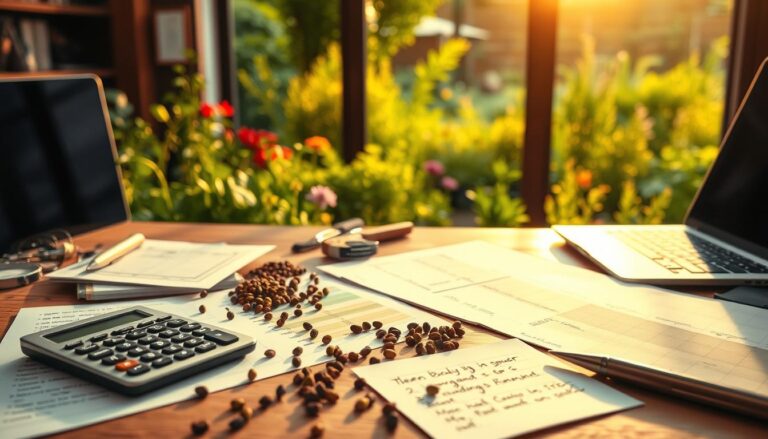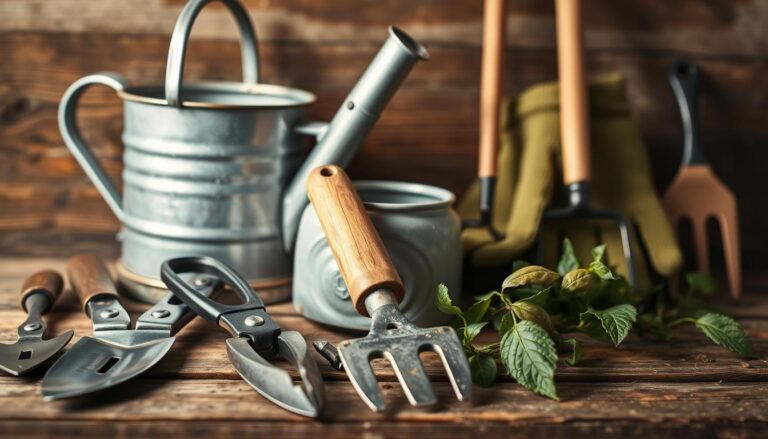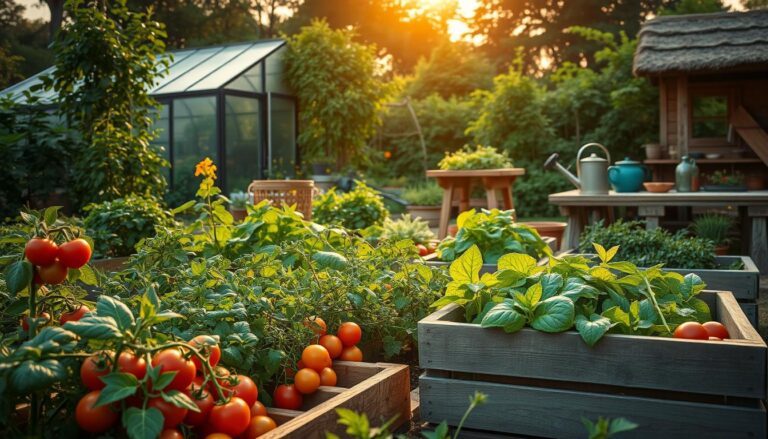Growing a thriving garden starts with choosing the right garden seeds. It might seem hard, but with the right help, you can make your backyard a lush oasis.
Nurturing your garden from seed to bloom needs careful planning and detail. Knowing how to pick the right seeds is key. It ensures a good harvest and a beautiful outdoor space.
Our guide will help you through this process. We’ll share valuable insights and expert tips for a flourishing garden.
Understanding Different Types of Garden Seeds
Knowing the types of garden seeds is key for any gardener. It’s important to pick the right seeds for a healthy garden. The right choice can make a big difference in your garden’s success.
Heirloom vs. Hybrid Seeds
Many gardeners debate between heirloom and hybrid seeds. Heirloom seeds are loved for their special traits and history.
Characteristics of Heirloom Seeds
Heirloom seeds are open-pollinated. This means they’re pollinated by bees, butterflies, or wind. Gardeners can save these seeds for next year’s garden.
These seeds come in many flavors, textures, and looks. This makes them a hit with gardeners who love variety.
Benefits of Hybrid Vigor
Hybrid seeds have “hybrid vigor.” This makes them stronger and more resistant to disease than heirloom seeds.
Hybrid seeds are made for specific traits. They might have more yield, better disease resistance, or handle stress better.
Open-Pollinated Seeds Explained
Open-pollinated seeds are pollinated naturally. They produce offspring with similar traits. Many heirloom varieties fall into this category.
GMO vs. Non-GMO Seeds
GMO (genetically modified organism) and non-GMO seeds are different. This choice is important for gardeners.
Legal Status in Home Gardening
In the U.S., GMO seed laws vary by state. Some states have rules about growing GMO seeds at home.
Gardeners should check their local laws before planting GMO seeds.
Selecting the Right Seeds for Your Garden: A Comprehensive Guide
A thriving garden starts with knowing your local growing conditions. It’s important to pick seeds that do well in those conditions. You need to consider your growing zone, garden space, and soil type.
Assessing Your Growing Zone
Knowing your growing zone is key. It tells you which plants can survive and grow well in your area.
Using the USDA Hardiness Zone Map
The USDA Hardiness Zone Map is a great tool for gardeners. It divides the country into zones based on temperature. Just find your zone and pick seeds that match it.
Microclimate Considerations
While the USDA Hardiness Zone Map is helpful, your garden’s microclimate can differ. Things like elevation and water proximity can affect your garden. Watching your garden’s specific conditions helps you choose better seeds.
Considering Your Garden Space
The size and layout of your garden matter in seed selection. Whether you garden in containers or have a big plot, the right seeds make a difference.
Container Gardening Seed Selection
For container gardening, choose compact or dwarf varieties. These plants are made for small spaces and can yield a lot.
Seeds for Small vs. Large Gardens
In small gardens, pick high-value crops that use little space. In bigger gardens, you can grow more varieties, including those needing more room.
| Garden Size | Recommended Crops | Space Requirements |
|---|---|---|
| Small | Leaf Lettuce, Cherry Tomatoes, Herbs | Minimal; can be grown in containers |
| Medium | Peppers, Cucumbers, Zucchini | Moderate; about 2-3 square feet per plant |
| Large | Carrots, Beans, Pumpkins | Significant; may require dedicated beds |
Matching Seeds to Your Soil Type
Soil type is crucial in seed selection. Different plants do better in different soils. It’s important to know your soil’s characteristics.
Testing your soil helps find its pH level and nutrient content. This lets you pick seeds that fit your soil well.
How to Choose Seeds Based on Your Gardening Experience
Choosing the right seeds is key, whether you’re new to gardening or have years of experience. It helps you avoid feeling overwhelmed or bored. You want to find a balance that suits your skill level.
Beginner-Friendly Seeds
For beginners, it’s best to start with plants that are easy to grow. These plants need little care and can forgive small mistakes.
Easy-to-Grow Vegetables
- Radishes: Quick to grow and ready to harvest in as little as 20 days.
- Leaf Lettuce: Easy to care for and can be harvested in about 40 days.
- Cherry Tomatoes: Produce fruit quickly and are relatively low maintenance.
Foolproof Flowers for First-Timers
- Zinnias: Brighten up any garden and are easy to grow from seed.
- Marigolds: Hardy and require minimal care.
- Sunflowers: Easy to grow and add a dramatic touch to your garden.
Intermediate Gardening Challenges
For those with some experience, it’s time to tackle more challenging plants. These plants need a bit more care and attention.
- Peppers: Require a bit more care than beginner plants but offer a rewarding harvest.
- Herbs like Basil: Need regular pruning and care but add flavor to a variety of dishes.
Advanced Seed Options for Experienced Gardeners
Experienced gardeners can try their hand at more exotic or delicate plants. These plants need precise care.
- Orchids: Require precise temperature and humidity conditions.
- Rare Vegetables: Such as certain varieties of heirloom tomatoes or exotic gourds.
Seasonal Considerations for Seed Selection
Choosing the right seeds at the right time is key to a successful garden. Different seasons need different seeds. Knowing what seeds to use in each season is essential for a thriving garden.
Spring Planting Seeds
Spring is a great time to plant many types of seeds. It can be split into early and late spring, each with its own seeds.
Early Spring Varieties
Early spring is perfect for cold-hardy seeds like lettuce, spinach, and peas. These plants do well in the cooler early spring weather.
Late Spring Options
As spring warms up, the soil is ready for seeds like tomatoes, peppers, and cucumbers. These warm-season crops need the warmer late spring weather.
Summer Garden Seeds
Summer is the best time for many plants to grow. It’s important to pick seeds that can handle the heat and long days.
Seeds for okra, squash, and sunflowers are great for summer gardens. These plants love the warmth and can handle the heat.
Fall and Winter Seed Selection
As summer ends, it’s time to think about fall and winter gardens. These seasons need seeds that can handle cooler temperatures and possibly frost.
Cold-Hardy Varieties
For fall and winter, choose cold-hardy varieties like kale, Brussels sprouts, and carrots. These plants can handle frost and keep producing well into the cold months.
By picking the right seeds for each season, you can have a garden that produces all year. Whether it’s spring, summer, fall, or winter, choosing the right seeds is crucial for a successful garden.
Organic Seeds: Benefits and Selection Tips
Organic seeds are great for gardeners. They improve soil health and make plants stronger. Choosing organic seeds helps gardeners grow in a way that’s good for the planet.
Why Choose Organic Seeds
Choosing organic seeds for your garden is good for the earth and your health. These seeds are made without harmful chemicals. They’re better for the environment and for those who want to eat food without chemicals.
The benefits of organic seeds include:
- Increased biodiversity in your garden
- Improved soil health through natural farming practices
- Resistant to pests and diseases due to their natural development
How to Identify Certified Organic Seeds
To get the best seeds, look for certifications from trusted groups. Certified organic seeds follow strict rules set by governments. This ensures they’re grown the right way.
Understanding Organic Certification Labels
Organic labels show that seeds are grown without harmful chemicals. In the U.S., the USDA Organic label is a common sign. It means the seeds meet organic farming standards.
“Choosing organic seeds is not just about avoiding chemicals; it’s about supporting a system that prioritizes soil health, biodiversity, and ecological balance.”
Top Organic Seed Varieties for Home Gardens
Heirloom tomatoes, kale, spinach, and herbs like basil and cilantro are great for home gardens. They grow well and taste amazing.
When picking best seeds for your garden, think about your climate, soil, and sunlight. The right organic seeds lead to a big harvest. They also support farming that’s good for the earth.
Seed Starting Techniques for Better Germination
Germination is the first step to a great harvest. It starts with the right seed starting techniques. Knowing the best methods can help your garden grow well.
Pre-Planting Treatments
Some seeds need special treatments before planting. These treatments can really help seeds grow better.
Scarification Methods
Scarification helps seeds start growing by breaking their outer layer. You can use a knife or sandpaper to do this.
- Nicking the seed coat with a sharp knife
- Rubbing seeds gently with sandpaper
- Soaking seeds in hot water
Stratification for Perennials
Stratification tricks seeds into thinking it’s winter. This is done by chilling them in a moist medium.
- Place seeds in a moistened medium like peat moss or sand.
- Store them in a refrigerator for the required period, usually several weeks.
- Check periodically to ensure the medium doesn’t dry out.
Indoor Seed Starting Tips
Starting seeds indoors can give your garden a head start. You need to mimic the conditions seeds need to grow.
Key considerations include:
- Using seed starting mix that’s specifically designed to support young seedlings.
- Providing adequate light, either through south-facing windows or grow lights.
- Maintaining a consistent temperature suitable for the seed type.
Direct Sowing Guidelines
Direct sowing means planting seeds straight into the garden. It’s simple but needs careful timing and preparation.
Timing for Direct Sowing
The right time to sow seeds depends on the seed type and climate. Wait until the soil is warm enough for germination.
| Seed Type | Optimal Soil Temperature | Best Time to Sow |
|---|---|---|
| Tomatoes | 55-70°F (13-21°C) | After last frost |
| Lettuce | 40-70°F (4-21°C) | Early spring or late summer |
| Peppers | 65-75°F (18-24°C) | After soil has warmed up |
Reliable Sources for Purchasing Quality Seeds
Choosing the right seeds is key for a healthy garden. There are many places to buy seeds, from online stores to local nurseries.
Reputable Seed Companies
Start with reputable seed companies for top-quality seeds. They have a wide range, including heirloom seeds for garden lovers.
Online Seed Retailers
Online seed stores let you shop from home. They often have more options than local shops. Some top online stores are:
- Burpee
- Seed Savers Exchange
- Renee’s Garden Seeds
Specialty Seed Sources
For unique seeds, check out specialty sources. They have rare and exotic varieties for specific needs.
Local Nurseries and Garden Centers
Local nurseries and garden centers are great for seeds. They have seeds for your area and offer advice.
Going to local nurseries lets you see the seeds and get tips from experts. They also host workshops and events for gardeners.
Seed Exchanges and Community Resources
Seed exchanges and community resources are also good for seeds. You can swap seeds with others for free or cheap.
Joining seed exchanges is fun and rewarding. It lets you try new seeds and meet other gardeners.
| Source | Benefits | Considerations |
|---|---|---|
| Online Seed Retailers | Convenient, wide selection | Shipping times, seed quality |
| Local Nurseries | Personalized advice, local suitability | Limited selection, seasonal availability |
| Seed Exchanges | Free or low-cost, community engagement | Quality variability, limited availability |
Reading and Understanding Seed Packets
To grow a thriving garden, knowing what seed packets say is key. These packets are not just envelopes with seeds. They are full of information to help you make smart choices for your garden.
Decoding Seed Packet Information
Seed packets have lots of details, like the seed type, variety name, and how to grow them. Knowing this info is vital for a successful garden.
Days to Maturity
“Days to maturity” tells you how long it takes for a plant to be ready to harvest. This helps you plan when to pick your crops and understand their growth.
Planting Dates
Planting dates show when it’s best to plant seeds. This depends on the weather, frost, and soil temperature. Paying attention to these dates can help your seeds grow better.
Understanding Germination Rates
Germination rate shows how many seeds should sprout under the best conditions. Knowing this helps you figure out how many seeds to plant to get the right number of plants.
Planting Depth and Spacing Guidelines
How deep and far apart to plant seeds is important for healthy growth. Seed packets usually give you these guidelines.
Thinning Requirements
Some plants need thinning to grow well and avoid disease. Seed packets might tell you if this is needed and how to do it right.
By carefully reading seed packets, gardeners can make better choices. This is true for both new and experienced gardeners. Understanding seed packet info can greatly improve your gardening success.
Conclusion: Growing Success Starts with Smart Seed Selection
Choosing the right seeds is the first step to a great harvest. Knowing the different types of seeds and your growing zone helps. It also matters how much space you have in your garden.
Whether you’re new to gardening or have lots of experience, picking the right seeds can be tough. But, by using the tips from this article, you can pick seeds that will do well in your garden. You’ll find the best seeds for your needs, from heirloom to hybrid, and for any time of year.
With the knowledge from this guide, you’re ready to grow a beautiful garden. Remember, picking the right seeds is a big step in your gardening journey. With the right seeds, you’ll have a garden that’s full of life and joy all year round.
FAQ
What are the benefits of using heirloom seeds in my garden?
How do I choose the right seeds for my gardening experience level?
What is the difference between open-pollinated and hybrid seeds?
How do I know if a seed is certified organic?
What are some reliable sources for purchasing quality seeds?
How do I read and understand seed packets?
What is seed scarification, and when is it necessary?
Can I save seeds from my harvest for next year’s garden?
How do I select seeds suitable for my climate and soil type?
What are some top organic seed varieties for home gardens?

Sortemdia nasceu com o propósito de trazer alegria e oportunidades para todos por meio de sorteios gratuitos de prêmios incríveis. O site tem como missão oferecer experiências acessíveis, divertidas e justas para quem deseja concorrer a produtos, serviços e brindes sem pagar nada por isso. Acreditamos que a sorte pode bater à porta de qualquer pessoa — e no Sortemdia, ela pode chegar com apenas um clique.



